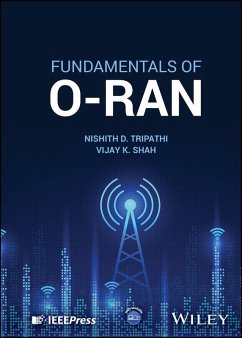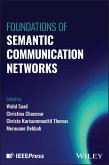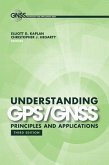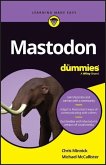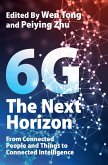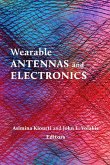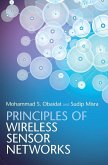- Gebundenes Buch
- Merkliste
- Auf die Merkliste
- Bewerten Bewerten
- Teilen
- Produkt teilen
- Produkterinnerung
- Produkterinnerung
Comprehensive reference on O-RAN technology, covering its history, architecture, security, ecosystem, and more, with didactic resources included throughout Discussing both basic and advanced concepts, Fundamentals of O-RAN delivers a comprehensive summary of O-RAN, covering its history, architecture, control loops and microservices (i.e., xApps and rApps), security, ecosystem, R&D initiatives, and challenges and evolution toward 6G. The book not only includes key theoretical principles of O-RAN, but also provides a framework for the reader to carry out guided hands-on exercises through online…mehr
Andere Kunden interessierten sich auch für
![Foundations of Semantic Communication Networks Foundations of Semantic Communication Networks]() Foundations of Semantic Communication Networks134,99 €
Foundations of Semantic Communication Networks134,99 €![Cellular Internet of Things Cellular Internet of Things]() Olof Liberg (Sweden Ericsson Business Unit Networks)Cellular Internet of Things116,99 €
Olof Liberg (Sweden Ericsson Business Unit Networks)Cellular Internet of Things116,99 €![Understanding Gps/Gnss Principles Understanding Gps/Gnss Principles]() Elliott KaplanUnderstanding Gps/Gnss Principles198,99 €
Elliott KaplanUnderstanding Gps/Gnss Principles198,99 €![Mastodon For Dummies Mastodon For Dummies]() Chris MinnickMastodon For Dummies12,99 €
Chris MinnickMastodon For Dummies12,99 €![6G 6G]() 6G105,99 €
6G105,99 €![Wearable Antennas and Electronics Wearable Antennas and Electronics]() Asimina KiourtiWearable Antennas and Electronics164,99 €
Asimina KiourtiWearable Antennas and Electronics164,99 €![Principles of Wireless Sensor Networks Principles of Wireless Sensor Networks]() Mohammad S. ObaidatPrinciples of Wireless Sensor Networks113,99 €
Mohammad S. ObaidatPrinciples of Wireless Sensor Networks113,99 €-
-
-
Comprehensive reference on O-RAN technology, covering its history, architecture, security, ecosystem, and more, with didactic resources included throughout Discussing both basic and advanced concepts, Fundamentals of O-RAN delivers a comprehensive summary of O-RAN, covering its history, architecture, control loops and microservices (i.e., xApps and rApps), security, ecosystem, R&D initiatives, and challenges and evolution toward 6G. The book not only includes key theoretical principles of O-RAN, but also provides a framework for the reader to carry out guided hands-on exercises through online auxiliary materials. Homework problems and review questions are included in online auxiliary materials to reinforce learning. The book includes instructions on how to create xApps, which are expected to be one of the most promising aspects of O-RAN; for example, by working with an end-to-end O-RAN system using a network slicing functionality where the rApp provides slicing specified policies to the xApp which then allocates the base station's spectrum resources based on the slicing policy to each user (belonging to a certain slice). Readers will also gain an understanding of cellular networks, particularly radio access networks, software virtualization, and software-defined networking concepts, and the knowledge needed to design, build, and test a 5G O-RAN system. Some of the sample topics explored in Fundamentals of O-RAN include: * RAN evolution from black box 4G RAN to software-based and virtualized RAN (vRAN) * Components of the O-RAN architecture including SMO, Non-RT RIC, Near-RT RIC, O-CU-CP, O-CU-UP, O-DU, O-RU, and O-Cloud * xApp design and prototyping from scratch using open cellular software, srsRAN and O-RAN Software Community (OSC) software. * Examination of various security dimensions inherent in the O-RAN architecture. * Testing and integration, covering Open Test and Integration Centers (OTICs), global PlugFests, certification and badging, and end-to-end test specifications * Work Groups (WGs), including WG1 to WG11, and focus groups, with information on how to obtain WG specifications Fundamentals of O-RAN is an essential reference for the workforce of tomorrow's cellular industry, including graduate students, teachers, researchers, faculty members, engineers, and employees involved in the field of wireless networks, especially radio networks.
Hinweis: Dieser Artikel kann nur an eine deutsche Lieferadresse ausgeliefert werden.
Hinweis: Dieser Artikel kann nur an eine deutsche Lieferadresse ausgeliefert werden.
Produktdetails
- Produktdetails
- Verlag: John Wiley & Sons Inc
- Seitenzahl: 336
- Erscheinungstermin: 28. Januar 2025
- Englisch
- Abmessung: 184mm x 263mm x 30mm
- Gewicht: 764g
- ISBN-13: 9781394206803
- ISBN-10: 1394206801
- Artikelnr.: 71561813
- Herstellerkennzeichnung
- Libri GmbH
- Europaallee 1
- 36244 Bad Hersfeld
- gpsr@libri.de
- Verlag: John Wiley & Sons Inc
- Seitenzahl: 336
- Erscheinungstermin: 28. Januar 2025
- Englisch
- Abmessung: 184mm x 263mm x 30mm
- Gewicht: 764g
- ISBN-13: 9781394206803
- ISBN-10: 1394206801
- Artikelnr.: 71561813
- Herstellerkennzeichnung
- Libri GmbH
- Europaallee 1
- 36244 Bad Hersfeld
- gpsr@libri.de
Dr. Nishith D. Tripathi is a Research Associate Professor at Virginia Tech. Dr. Tripathi has 24 years of industry experience at Nortel Networks, Huawei Technologies, Award Solutions, and Samsung Research America. He is a co-author of five books related to cellular communications, AI, 5G, and NTN. Dr. Vijay K. Shah is an Assistant Professor at North Carolina State University. Prior to joining NC State, he was an Assistant Professor at George Mason University (GMU) and a Research Assistant Professor at Virginia Tech.
About the Authors xiii Preface xv Acknowledgments xix Acronyms xxi About the Companion Website xxxi 1 Introduction to O-RAN 1 1.1 Evolution of Cellular Technologies 1 1.2 Components of Cellular Systems 3 1.3 Evolution of the RAN 4 1.3.1 Horizontal Disaggregation of RAN: A Protocol Perspective 5 1.4 Introduction to the O-RAN ALLIANCE and the O-RAN Architecture 7 1.4.1 O-RAN ALLIANCE: A Brief Overview 7 1.4.2 The O-RAN Architecture in a Nutshell 8 1.4.3 Groups in the O-RAN ALLIANCE 10 1.5 Driving Forces Behind O-RAN 10 1.6 O-RAN Ecosystem 12 1.7 O-RAN Use Cases 14 1.7.1 Context-Based Dynamic HO Management for V2X 14 1.7.2 Flight Path-Based Dynamic UAV Radio Resource Allocation 15 1.7.3 Radio Resource Allocation for UAV Application Scenario 15 1.7.4 QoE Optimization 16 1.7.5 Traffic Steering 16 1.7.6 Massive MIMO Beamforming Optimization 16 1.7.7 RAN Sharing 17 1.7.8 QoS-Based Resource Optimization 17 1.7.9 RAN Slice SLA Assurance 17 1.7.10 Multivendor Slices 18 1.7.11 3GPP 4G/5G Dynamic Spectrum Sharing (DSS) 18 1.7.12 NSSI Resource Allocation Optimization 18 1.7.13 Local Indoor Positioning in RAN 19 1.7.14 Massive MIMO SU/MU-MIMO Grouping Optimization 19 1.7.15 O-RAN Signaling Storm Protection 19 1.7.16 Congestion Prediction and Management 20 1.7.17 Industrial IoT Optimization 20 1.7.18 BBU Pooling to Achieve RAN Elasticity 21 1.7.19 Integrated SON Function 22 1.7.20 Shared O-RU 22 1.7.21 Energy Saving 23 1.7.22 MU-MIMO Optimization 23 1.7.23 Sharing Non-RT RIC Data with the Core 23 1.7.24 Industrial Vision SLA Assurance 25 1.7.25 Non-Public Network (NPN) RAN-Sharing via Midhaul for Multioperator Coverage 25 1.7.26 Interference Detection and Optimization 25 1.8 O-RAN: Accomplishments, Technical Priorities, and Potential Future Work 26 1.8.1 O-RAN Accomplishments 26 1.8.2 O-RAN Technical Priorities 26 1.8.3 Role of O-RAN Beyond 5G 27 1.9 Major Takeaways of the Chapter 27 References 28 2 O-RAN Architecture 31 2.1 O-RAN Logical Architecture 31 2.2 O-RAN Components: A Closer Look 34 2.2.1 SMO and Non-RT RIC: A Closer Look 34 2.2.1.1 SMO Support for FCAPS to O-RAN Network Functions 34 2.2.1.2 SMO: O-Cloud Management, Orchestration, and Workflow Management 35 2.2.1.3 Non-RT RIC 35 2.2.1.4 Logical Functions in the Non-RT RIC Framework or the SMO Framework 38 2.2.2 Near-RT RIC 39 2.2.3 O-cu-cp 42 2.2.4 O-cu-up 43 2.2.5 O-du 44 2.2.6 O-ru 45 2.2.7 O-eNB 46 2.2.8 O-Cloud 47 2.3 O-RAN Interfaces: A Closer Look 49 2.3.1 O1 Interface 49 2.3.2 O2 Interface 52 2.3.3 A1 Interface 53 2.3.3.1 A1 Policies and A1 Policy Management 53 2.3.3.2 A1 Enrichment Information (EI) and A1 EI Service 54 2.3.3.3 ml Model Management Service 54 2.3.3.4 A1 Interface Protocol Stack 54 2.3.4 E2 Interface 55 2.3.5 Open FH Interface 58 2.3.5.1 M-Plane: A Closer Look 58 2.3.5.2 CUS-Plane: A Closer Look 60 2.3.6 O-Cloud Notification Interface 63 2.3.7 CTI (Cooperative Transport Interface) 63 2.3.8 3GPP Interfaces Relevant to O-RAN 65 2.4 Functional Split 7.2x 66 2.5 Inside O-RAN Domain: Functional Distribution Between O-RAN and Other SDOs 68 2.6 O-RAN Deployment Scenarios 68 2.6.1 Hierarchical Cloud Architecture 68 2.6.2 O-RAN Cloud Deployment Scenarios 69 2.6.3 Example Mapping of O-RU Functions to Hierarchical O-RAN Cloud Architecture 70 2.7 Major Takeaways of the Chapter 71 References 72 3 O-RAN Applications: xApps and rApps 75 3.1 O-RAN Control Loops 75 3.2 Near-RT Control Loop: Near-RT RIC and xApps 76 3.2.1 Near-RT Internal Components of the Near-RT RIC 76 3.2.2 Open-Source Near-RT RIC Implementations 78 3.3 Near-RT RIC xApps: Enabling RAN Customization 79 3.3.1 Defining xApps 79 3.3.2 Embracing Evolving Standards 80 3.4 E2 Interface: Empowering RAN Control and Data Exchange 81 3.4.1 E2 Application Protocol (E2AP) 82 3.4.2 E2 Service Models 84 3.5 xApp Use Cases 86 3.5.1 KPIMON xApp 86 3.5.2 RAN Slicing xApp 88 3.5.2.1 RAN Slicing Configuration and Resource Allocation 89 3.5.2.2 Throughput Performance 89 3.6 Machine Learning (ML)-Based xApps 90 3.6.1 AI/ML Workflow 90 3.6.1.1 Data Collection and Processing 91 3.6.1.2 Training 91 3.6.1.3 Validation and Publishing 91 3.6.1.4 Deployment 91 3.6.1.5 AI/ML Execution and Inference 91 3.6.1.6 Continuous Operations 91 3.6.2 Example ML-Based xApp Use Cases 92 3.7 xApp Workflow 93 3.8 xApp Development: A Closer Look 94 3.8.1 Undeployment/Removal of xApps 101 3.9 Non-RT Closed Loop: Non-RT RIC and rApps 102 3.9.1 Requirements for the Non-RT RIC Framework 102 3.9.2 Non-RT RIC Architecture 103 3.9.2.1 A1 Interface: General Principles 104 3.9.2.2 Role of the A1 Interface 105 3.9.2.3 A1-P Management Service (A1-P) 106 3.9.2.4 A1 Enrichment Information Service (A1-EI) 106 3.9.2.5 A1 ML Model Management Service (A1-ML) 107 3.9.3 R1 Interface 108 3.9.3.1 R1 Service Definitions 109 3.9.4 Service Management and Orchestration 112 3.9.5 rApp Use Cases 113 3.9.5.1 Traffic Steering Use Case 113 3.9.5.2 QoE Use Case 114 3.9.5.3 Operational Flow 114 3.10 Real-Time RIC Closed Loop: RT RIC and
Apps/dApps 115 3.10.1 Resource Block (RB) Scheduling
App 117 3.10.1.1 Workflow for a RB Scheduling
App 117 3.10.1.2 Other Features and Future Directions 117 3.10.2 Beam Management dApp Use Case 118 3.10.2.1 Key Elements and Their Functions 118 3.10.2.2 Operational Flow for Beam Management 118 3.11 Multi-time-scale RIC Framework 119 3.11.1 Use Case: SPARC for Multi-Site Spectrum Management 120 3.11.2 Key Elements and Operational Flow for SPARC Framework 120 3.12 Major Takeaways of the Chapter 121 References 122 4 O-RAN Security 125 4.1 Motivation for O-RAN Security 125 4.1.1 Vulnerabilities of O-RAN Compared to Non-O-RAN Implementations 126 4.1.2 Scope of O-RAN Security Specifications 127 4.1.2.1 Within O-RAN Security Scope 127 4.1.2.2 Outside O-RAN Security Scope 128 4.1.3 Critical Assets 128 4.1.3.1 Critical Data Assets 129 4.1.3.2 Critical Component Assets 129 4.1.4 Protection Levels 130 4.2 Methodology of O-RAN Security Analysis 130 4.2.1 Stage 1: Risk Identification 130 4.2.2 Stage 2: Risk Assessment 133 4.2.3 Stage 3: Risk Treatment 133 4.3 Threat Model 134 4.3.1 Building Blocks of the Threat Model 134 4.3.2 An Overview of O-RAN Security Threats 135 4.3.2.1 Threats Against O-RAN System 135 4.3.2.2 Threats Against O-Cloud 138 4.3.2.3 Threats to Open-Source Code 141 4.3.2.4 Physical Threats 141 4.3.2.5 Threats Against 5G Radio Networks 142 4.3.2.6 Threats Against ML System 142 4.3.2.7 Protocol Stack Threats 143 4.3.3 O-RAN Threat Agents 143 4.3.4 Potential Security Vulnerabilities of O-RAN 145 4.4 Risk Assessment 145 4.4.1 Key Elements of Risk Assessment 146 4.4.2 O-RAN Risk Assessment Analysis: A Brief Overview 148 4.5 Security Principles, Security Requirements, and Security Controls in O-RAN 152 4.5.1 O-RAN Security Principles 152 4.5.2 Security Requirements for O-RAN 157 4.5.3 Security Controls for O-RAN 159 4.6 O-RAN Security Protocols 161 4.6.1 Security Protocols in a Nutshell 161 4.6.2 Ssh 161 4.6.3 Tls 162 4.6.4 Dtls 162 4.6.5 NETCONF over Secure Transport 163 4.6.6 IPsec 163 4.6.7 CMPv 2 164 4.6.8 OAuth 2.0 165 4.7 O-RAN Security Testing 165 4.7.1 Tools for O-RAN Security Testing 166 4.7.2 Test Report Template 166 4.7.3 Security Testing Framework 168 4.7.3.1 Security Protocol Validation 168 4.7.3.2 Common Network Security Tests and System Security Tests for O-RAN Components 171 4.7.3.3 Software Security Evaluation 174 4.7.3.4 Open Fronthaul Security Validation 175 4.7.3.5 Validation of O-RAN-Component-Specific Security Protection Mechanisms 175 4.7.3.6 Security Testing of xApps and rApps 177 4.7.3.7 Validation of Miscellaneous Components 178 4.8 Major Takeaways of the Chapter 178 References 179 5 O-RAN Ecosystem 181 5.1 Internal and External O-RAN Ecosystems 181 5.2 Internal O-RAN Ecosystem 182 5.2.1 Work Groups of O-RAN Specification Efforts 182 5.2.1.1 WG1 Work Products 183 5.2.1.2 WG2 Work Products 183 5.2.1.3 WG3 Work Products 184 5.2.1.4 WG4 Work Products 184 5.2.1.5 WG5 Work Products 184 5.2.1.6 WG6 Work Products 184 5.2.1.7 WG7 Work Products 184 5.2.1.8 WG8 Work Products 185 5.2.1.9 WG9 Work Products 185 5.2.1.10 WG10 Work Products 185 5.2.1.11 WG11 Work Products 186 5.2.2 Focus and Research Groups of O-RAN 186 5.2.3 Testing and Integration Entities 191 5.2.4 O-RAN Demonstrators and O-RAN Field Trials and Development Entities 194 5.2.5 O-RAN Software Community 195 5.3 External Ecosystem 196 5.3.1 Standards Developing Organizations (SDOs) 197 5.3.2 Commercial Developers of xApps and rApps 198 5.3.3 System Integrators 199 5.3.4 Service Providers 200 5.3.5 Government Entities 200 5.3.6 Industry Organizations 200 5.3.7 Academic Institutions 200 5.4 O-RAN: A Deployment Perspective 201 5.5 Major Takeaways of the Chapter 203 References 203 6 O-RAN Testing and Integration 207 6.1 O-RAN Testing and Integration in a Nutshell 207 6.2 Test Specifications 208 6.2.1 Conformance and Interoperability Testing 208 6.2.1.1 O-RAN A1 Interface: Test Specification 208 6.2.1.2 O-RAN E2 Interface Test Specification 211 6.2.1.3 O-RAN Fronthaul Conformance Test Specification 213 6.2.1.4 O-RAN Fronthaul Interoperability Test Specification 216 6.2.1.5 O-RAN WG5 Interoperability Test Specification 217 6.2.1.6 O-RAN Cloud Conformance Test Specification 218 6.2.1.7 O-RAN O-Cloud Interoperability Test (IOT) Specification 219 6.2.1.8 O-RAN Stack Interoperability Test Specification 220 6.2.2 End-to-End Testing 220 6.2.2.1 O-RAN End-to-End Test Specification 221 6.2.2.2 Functional Tests 224 6.2.2.3 Performance Tests 224 6.2.2.4 Service Tests 225 6.2.2.5 Load and Stress Tests 225 6.2.2.6 RIC-Enabled E2E Use Case Tests 225 6.3 Open Testing and Integration Centers 226 6.4 Global PlugFests 227 6.5 Certification and Badging 228 6.6 Major Takeaways of the Chapter 229 References 230 7 O-RAN Research and Development Initiatives 233 7.1 Industry-Led Initiatives 233 7.1.1 O-ran Alliance 233 7.1.1.1 O-RAN Specifications 233 7.1.1.2 O-RAN Software 233 7.1.1.3 O-RAN Demonstrations 234 7.1.1.4 Testing and Integration of O-RAN Implementations 234 7.1.2 Telecom Infra Project (TIP) 234 7.1.2.1 Component Subgroup 235 7.1.2.2 Segment Subgroup 237 7.1.3 Open Networking Foundation (ONF) 237 7.1.4 Cloud Service Providers 241 7.1.5 Major Telecom Vendors 241 7.1.6 Major Telecom Operators 244 7.1.6.1 North America 245 7.1.6.2 Japan 246 7.1.6.3 India 246 7.1.6.4 Thailand 247 7.1.6.5 Indonesia 247 7.1.6.6 Malaysia 247 7.1.6.7 Australia 247 7.1.6.8 Europe 247 7.1.6.9 South America 248 7.1.6.10 Africa 248 7.1.6.11 Middle-East 249 7.1.7 Major Testing Vendors 249 7.2 Government-Led Initiatives 251 7.2.1 NTIA Wireless Innovation Fund 251 7.2.2 The RIC Forum 251 7.2.3 DoD Innovate Beyond 5G Program 251 7.2.4 DoD and National Spectrum Consortium Effort on O-RAN Acceleration 252 7.2.5 DoD and OUSD 5G Challenge 252 7.2.6 National Defense Authorization Act (NDAA) 252 7.3 Academia-Led Initiatives 253 7.3.1 Open AI Cellular (OAIC) Platform 253 7.3.2 Colosseum 255 7.3.3 OpenRAN Gym 256 7.3.4 ColO-RAN Platform 256 7.3.5 Powder 257 7.3.6 Commonwealth Cyber Initiative (CCI) xG Testbed 258 7.3.7 AERPAW Testbed 259 7.3.8 ARA Testbed 260 7.3.9 5GENESIS Consortium 260 7.3.10 5G-EmPOWER 261 7.4 Major Takeaways of the Chapter 261 References 261 8 O-RAN Challenges and Evolution of O-RAN Toward 6G 265 8.1 O-RAN Challenges and Solutions 265 8.1.1 O-RAN Challenges and Solutions: An Overview 265 8.1.2 O-RAN Challenges and Solutions: A Closer Look 266 8.1.2.1 Orchestration and OAM 266 8.1.2.2 Performance 267 8.1.2.3 Security 269 8.1.2.4 Product Development 270 8.1.2.5 Total Cost of Ownership 270 8.1.2.6 Interoperability 271 8.1.2.7 RAN Product Performance 271 8.1.2.8 Multivendor Operational Complexity 272 8.2 6G: A Concise Introduction 273 8.2.1 6G Usage Scenarios 273 8.2.1.1 Immersive Communications 274 8.2.1.2 Massive Communication 274 8.2.1.3 Hrllc 274 8.2.1.4 Ubiquitous Connectivity 274 8.2.1.5 Integrated AI and Communication 274 8.2.1.6 Integrated Sensing and Communication 274 8.2.2 6G Capabilities and Performance Targets 274 8.2.3 6G Technology Enablers 276 8.2.3.1 Component Technologies 276 8.2.3.2 Radio Technologies 277 8.2.3.3 System and Network Architectures 277 8.2.3.4 OAM and Service Enablement 277 8.2.3.5 Trustworthiness 277 8.3 O-RAN in 6G 277 8.3.1 Use Cases 278 8.3.2 Domains for 6G Architecture 279 8.3.3 O-RAN Architecture Work Areas 279 8.3.4 New Air Interface 279 8.3.5 O-RAN Components in the 6G Network 280 8.3.6 Priorities of Network Layers 280 8.3.7 Tools 280 8.3.8 Security 280 8.3.9 Resilience 280 8.4 Major Takeaways of the Chapter 281 References 282 Appendix A Energy Efficiency in Open Radio Access Networks 283 Index 291
Apps/dApps 115 3.10.1 Resource Block (RB) Scheduling
App 117 3.10.1.1 Workflow for a RB Scheduling
App 117 3.10.1.2 Other Features and Future Directions 117 3.10.2 Beam Management dApp Use Case 118 3.10.2.1 Key Elements and Their Functions 118 3.10.2.2 Operational Flow for Beam Management 118 3.11 Multi-time-scale RIC Framework 119 3.11.1 Use Case: SPARC for Multi-Site Spectrum Management 120 3.11.2 Key Elements and Operational Flow for SPARC Framework 120 3.12 Major Takeaways of the Chapter 121 References 122 4 O-RAN Security 125 4.1 Motivation for O-RAN Security 125 4.1.1 Vulnerabilities of O-RAN Compared to Non-O-RAN Implementations 126 4.1.2 Scope of O-RAN Security Specifications 127 4.1.2.1 Within O-RAN Security Scope 127 4.1.2.2 Outside O-RAN Security Scope 128 4.1.3 Critical Assets 128 4.1.3.1 Critical Data Assets 129 4.1.3.2 Critical Component Assets 129 4.1.4 Protection Levels 130 4.2 Methodology of O-RAN Security Analysis 130 4.2.1 Stage 1: Risk Identification 130 4.2.2 Stage 2: Risk Assessment 133 4.2.3 Stage 3: Risk Treatment 133 4.3 Threat Model 134 4.3.1 Building Blocks of the Threat Model 134 4.3.2 An Overview of O-RAN Security Threats 135 4.3.2.1 Threats Against O-RAN System 135 4.3.2.2 Threats Against O-Cloud 138 4.3.2.3 Threats to Open-Source Code 141 4.3.2.4 Physical Threats 141 4.3.2.5 Threats Against 5G Radio Networks 142 4.3.2.6 Threats Against ML System 142 4.3.2.7 Protocol Stack Threats 143 4.3.3 O-RAN Threat Agents 143 4.3.4 Potential Security Vulnerabilities of O-RAN 145 4.4 Risk Assessment 145 4.4.1 Key Elements of Risk Assessment 146 4.4.2 O-RAN Risk Assessment Analysis: A Brief Overview 148 4.5 Security Principles, Security Requirements, and Security Controls in O-RAN 152 4.5.1 O-RAN Security Principles 152 4.5.2 Security Requirements for O-RAN 157 4.5.3 Security Controls for O-RAN 159 4.6 O-RAN Security Protocols 161 4.6.1 Security Protocols in a Nutshell 161 4.6.2 Ssh 161 4.6.3 Tls 162 4.6.4 Dtls 162 4.6.5 NETCONF over Secure Transport 163 4.6.6 IPsec 163 4.6.7 CMPv 2 164 4.6.8 OAuth 2.0 165 4.7 O-RAN Security Testing 165 4.7.1 Tools for O-RAN Security Testing 166 4.7.2 Test Report Template 166 4.7.3 Security Testing Framework 168 4.7.3.1 Security Protocol Validation 168 4.7.3.2 Common Network Security Tests and System Security Tests for O-RAN Components 171 4.7.3.3 Software Security Evaluation 174 4.7.3.4 Open Fronthaul Security Validation 175 4.7.3.5 Validation of O-RAN-Component-Specific Security Protection Mechanisms 175 4.7.3.6 Security Testing of xApps and rApps 177 4.7.3.7 Validation of Miscellaneous Components 178 4.8 Major Takeaways of the Chapter 178 References 179 5 O-RAN Ecosystem 181 5.1 Internal and External O-RAN Ecosystems 181 5.2 Internal O-RAN Ecosystem 182 5.2.1 Work Groups of O-RAN Specification Efforts 182 5.2.1.1 WG1 Work Products 183 5.2.1.2 WG2 Work Products 183 5.2.1.3 WG3 Work Products 184 5.2.1.4 WG4 Work Products 184 5.2.1.5 WG5 Work Products 184 5.2.1.6 WG6 Work Products 184 5.2.1.7 WG7 Work Products 184 5.2.1.8 WG8 Work Products 185 5.2.1.9 WG9 Work Products 185 5.2.1.10 WG10 Work Products 185 5.2.1.11 WG11 Work Products 186 5.2.2 Focus and Research Groups of O-RAN 186 5.2.3 Testing and Integration Entities 191 5.2.4 O-RAN Demonstrators and O-RAN Field Trials and Development Entities 194 5.2.5 O-RAN Software Community 195 5.3 External Ecosystem 196 5.3.1 Standards Developing Organizations (SDOs) 197 5.3.2 Commercial Developers of xApps and rApps 198 5.3.3 System Integrators 199 5.3.4 Service Providers 200 5.3.5 Government Entities 200 5.3.6 Industry Organizations 200 5.3.7 Academic Institutions 200 5.4 O-RAN: A Deployment Perspective 201 5.5 Major Takeaways of the Chapter 203 References 203 6 O-RAN Testing and Integration 207 6.1 O-RAN Testing and Integration in a Nutshell 207 6.2 Test Specifications 208 6.2.1 Conformance and Interoperability Testing 208 6.2.1.1 O-RAN A1 Interface: Test Specification 208 6.2.1.2 O-RAN E2 Interface Test Specification 211 6.2.1.3 O-RAN Fronthaul Conformance Test Specification 213 6.2.1.4 O-RAN Fronthaul Interoperability Test Specification 216 6.2.1.5 O-RAN WG5 Interoperability Test Specification 217 6.2.1.6 O-RAN Cloud Conformance Test Specification 218 6.2.1.7 O-RAN O-Cloud Interoperability Test (IOT) Specification 219 6.2.1.8 O-RAN Stack Interoperability Test Specification 220 6.2.2 End-to-End Testing 220 6.2.2.1 O-RAN End-to-End Test Specification 221 6.2.2.2 Functional Tests 224 6.2.2.3 Performance Tests 224 6.2.2.4 Service Tests 225 6.2.2.5 Load and Stress Tests 225 6.2.2.6 RIC-Enabled E2E Use Case Tests 225 6.3 Open Testing and Integration Centers 226 6.4 Global PlugFests 227 6.5 Certification and Badging 228 6.6 Major Takeaways of the Chapter 229 References 230 7 O-RAN Research and Development Initiatives 233 7.1 Industry-Led Initiatives 233 7.1.1 O-ran Alliance 233 7.1.1.1 O-RAN Specifications 233 7.1.1.2 O-RAN Software 233 7.1.1.3 O-RAN Demonstrations 234 7.1.1.4 Testing and Integration of O-RAN Implementations 234 7.1.2 Telecom Infra Project (TIP) 234 7.1.2.1 Component Subgroup 235 7.1.2.2 Segment Subgroup 237 7.1.3 Open Networking Foundation (ONF) 237 7.1.4 Cloud Service Providers 241 7.1.5 Major Telecom Vendors 241 7.1.6 Major Telecom Operators 244 7.1.6.1 North America 245 7.1.6.2 Japan 246 7.1.6.3 India 246 7.1.6.4 Thailand 247 7.1.6.5 Indonesia 247 7.1.6.6 Malaysia 247 7.1.6.7 Australia 247 7.1.6.8 Europe 247 7.1.6.9 South America 248 7.1.6.10 Africa 248 7.1.6.11 Middle-East 249 7.1.7 Major Testing Vendors 249 7.2 Government-Led Initiatives 251 7.2.1 NTIA Wireless Innovation Fund 251 7.2.2 The RIC Forum 251 7.2.3 DoD Innovate Beyond 5G Program 251 7.2.4 DoD and National Spectrum Consortium Effort on O-RAN Acceleration 252 7.2.5 DoD and OUSD 5G Challenge 252 7.2.6 National Defense Authorization Act (NDAA) 252 7.3 Academia-Led Initiatives 253 7.3.1 Open AI Cellular (OAIC) Platform 253 7.3.2 Colosseum 255 7.3.3 OpenRAN Gym 256 7.3.4 ColO-RAN Platform 256 7.3.5 Powder 257 7.3.6 Commonwealth Cyber Initiative (CCI) xG Testbed 258 7.3.7 AERPAW Testbed 259 7.3.8 ARA Testbed 260 7.3.9 5GENESIS Consortium 260 7.3.10 5G-EmPOWER 261 7.4 Major Takeaways of the Chapter 261 References 261 8 O-RAN Challenges and Evolution of O-RAN Toward 6G 265 8.1 O-RAN Challenges and Solutions 265 8.1.1 O-RAN Challenges and Solutions: An Overview 265 8.1.2 O-RAN Challenges and Solutions: A Closer Look 266 8.1.2.1 Orchestration and OAM 266 8.1.2.2 Performance 267 8.1.2.3 Security 269 8.1.2.4 Product Development 270 8.1.2.5 Total Cost of Ownership 270 8.1.2.6 Interoperability 271 8.1.2.7 RAN Product Performance 271 8.1.2.8 Multivendor Operational Complexity 272 8.2 6G: A Concise Introduction 273 8.2.1 6G Usage Scenarios 273 8.2.1.1 Immersive Communications 274 8.2.1.2 Massive Communication 274 8.2.1.3 Hrllc 274 8.2.1.4 Ubiquitous Connectivity 274 8.2.1.5 Integrated AI and Communication 274 8.2.1.6 Integrated Sensing and Communication 274 8.2.2 6G Capabilities and Performance Targets 274 8.2.3 6G Technology Enablers 276 8.2.3.1 Component Technologies 276 8.2.3.2 Radio Technologies 277 8.2.3.3 System and Network Architectures 277 8.2.3.4 OAM and Service Enablement 277 8.2.3.5 Trustworthiness 277 8.3 O-RAN in 6G 277 8.3.1 Use Cases 278 8.3.2 Domains for 6G Architecture 279 8.3.3 O-RAN Architecture Work Areas 279 8.3.4 New Air Interface 279 8.3.5 O-RAN Components in the 6G Network 280 8.3.6 Priorities of Network Layers 280 8.3.7 Tools 280 8.3.8 Security 280 8.3.9 Resilience 280 8.4 Major Takeaways of the Chapter 281 References 282 Appendix A Energy Efficiency in Open Radio Access Networks 283 Index 291
About the Authors xiii Preface xv Acknowledgments xix Acronyms xxi About the Companion Website xxxi 1 Introduction to O-RAN 1 1.1 Evolution of Cellular Technologies 1 1.2 Components of Cellular Systems 3 1.3 Evolution of the RAN 4 1.3.1 Horizontal Disaggregation of RAN: A Protocol Perspective 5 1.4 Introduction to the O-RAN ALLIANCE and the O-RAN Architecture 7 1.4.1 O-RAN ALLIANCE: A Brief Overview 7 1.4.2 The O-RAN Architecture in a Nutshell 8 1.4.3 Groups in the O-RAN ALLIANCE 10 1.5 Driving Forces Behind O-RAN 10 1.6 O-RAN Ecosystem 12 1.7 O-RAN Use Cases 14 1.7.1 Context-Based Dynamic HO Management for V2X 14 1.7.2 Flight Path-Based Dynamic UAV Radio Resource Allocation 15 1.7.3 Radio Resource Allocation for UAV Application Scenario 15 1.7.4 QoE Optimization 16 1.7.5 Traffic Steering 16 1.7.6 Massive MIMO Beamforming Optimization 16 1.7.7 RAN Sharing 17 1.7.8 QoS-Based Resource Optimization 17 1.7.9 RAN Slice SLA Assurance 17 1.7.10 Multivendor Slices 18 1.7.11 3GPP 4G/5G Dynamic Spectrum Sharing (DSS) 18 1.7.12 NSSI Resource Allocation Optimization 18 1.7.13 Local Indoor Positioning in RAN 19 1.7.14 Massive MIMO SU/MU-MIMO Grouping Optimization 19 1.7.15 O-RAN Signaling Storm Protection 19 1.7.16 Congestion Prediction and Management 20 1.7.17 Industrial IoT Optimization 20 1.7.18 BBU Pooling to Achieve RAN Elasticity 21 1.7.19 Integrated SON Function 22 1.7.20 Shared O-RU 22 1.7.21 Energy Saving 23 1.7.22 MU-MIMO Optimization 23 1.7.23 Sharing Non-RT RIC Data with the Core 23 1.7.24 Industrial Vision SLA Assurance 25 1.7.25 Non-Public Network (NPN) RAN-Sharing via Midhaul for Multioperator Coverage 25 1.7.26 Interference Detection and Optimization 25 1.8 O-RAN: Accomplishments, Technical Priorities, and Potential Future Work 26 1.8.1 O-RAN Accomplishments 26 1.8.2 O-RAN Technical Priorities 26 1.8.3 Role of O-RAN Beyond 5G 27 1.9 Major Takeaways of the Chapter 27 References 28 2 O-RAN Architecture 31 2.1 O-RAN Logical Architecture 31 2.2 O-RAN Components: A Closer Look 34 2.2.1 SMO and Non-RT RIC: A Closer Look 34 2.2.1.1 SMO Support for FCAPS to O-RAN Network Functions 34 2.2.1.2 SMO: O-Cloud Management, Orchestration, and Workflow Management 35 2.2.1.3 Non-RT RIC 35 2.2.1.4 Logical Functions in the Non-RT RIC Framework or the SMO Framework 38 2.2.2 Near-RT RIC 39 2.2.3 O-cu-cp 42 2.2.4 O-cu-up 43 2.2.5 O-du 44 2.2.6 O-ru 45 2.2.7 O-eNB 46 2.2.8 O-Cloud 47 2.3 O-RAN Interfaces: A Closer Look 49 2.3.1 O1 Interface 49 2.3.2 O2 Interface 52 2.3.3 A1 Interface 53 2.3.3.1 A1 Policies and A1 Policy Management 53 2.3.3.2 A1 Enrichment Information (EI) and A1 EI Service 54 2.3.3.3 ml Model Management Service 54 2.3.3.4 A1 Interface Protocol Stack 54 2.3.4 E2 Interface 55 2.3.5 Open FH Interface 58 2.3.5.1 M-Plane: A Closer Look 58 2.3.5.2 CUS-Plane: A Closer Look 60 2.3.6 O-Cloud Notification Interface 63 2.3.7 CTI (Cooperative Transport Interface) 63 2.3.8 3GPP Interfaces Relevant to O-RAN 65 2.4 Functional Split 7.2x 66 2.5 Inside O-RAN Domain: Functional Distribution Between O-RAN and Other SDOs 68 2.6 O-RAN Deployment Scenarios 68 2.6.1 Hierarchical Cloud Architecture 68 2.6.2 O-RAN Cloud Deployment Scenarios 69 2.6.3 Example Mapping of O-RU Functions to Hierarchical O-RAN Cloud Architecture 70 2.7 Major Takeaways of the Chapter 71 References 72 3 O-RAN Applications: xApps and rApps 75 3.1 O-RAN Control Loops 75 3.2 Near-RT Control Loop: Near-RT RIC and xApps 76 3.2.1 Near-RT Internal Components of the Near-RT RIC 76 3.2.2 Open-Source Near-RT RIC Implementations 78 3.3 Near-RT RIC xApps: Enabling RAN Customization 79 3.3.1 Defining xApps 79 3.3.2 Embracing Evolving Standards 80 3.4 E2 Interface: Empowering RAN Control and Data Exchange 81 3.4.1 E2 Application Protocol (E2AP) 82 3.4.2 E2 Service Models 84 3.5 xApp Use Cases 86 3.5.1 KPIMON xApp 86 3.5.2 RAN Slicing xApp 88 3.5.2.1 RAN Slicing Configuration and Resource Allocation 89 3.5.2.2 Throughput Performance 89 3.6 Machine Learning (ML)-Based xApps 90 3.6.1 AI/ML Workflow 90 3.6.1.1 Data Collection and Processing 91 3.6.1.2 Training 91 3.6.1.3 Validation and Publishing 91 3.6.1.4 Deployment 91 3.6.1.5 AI/ML Execution and Inference 91 3.6.1.6 Continuous Operations 91 3.6.2 Example ML-Based xApp Use Cases 92 3.7 xApp Workflow 93 3.8 xApp Development: A Closer Look 94 3.8.1 Undeployment/Removal of xApps 101 3.9 Non-RT Closed Loop: Non-RT RIC and rApps 102 3.9.1 Requirements for the Non-RT RIC Framework 102 3.9.2 Non-RT RIC Architecture 103 3.9.2.1 A1 Interface: General Principles 104 3.9.2.2 Role of the A1 Interface 105 3.9.2.3 A1-P Management Service (A1-P) 106 3.9.2.4 A1 Enrichment Information Service (A1-EI) 106 3.9.2.5 A1 ML Model Management Service (A1-ML) 107 3.9.3 R1 Interface 108 3.9.3.1 R1 Service Definitions 109 3.9.4 Service Management and Orchestration 112 3.9.5 rApp Use Cases 113 3.9.5.1 Traffic Steering Use Case 113 3.9.5.2 QoE Use Case 114 3.9.5.3 Operational Flow 114 3.10 Real-Time RIC Closed Loop: RT RIC and
Apps/dApps 115 3.10.1 Resource Block (RB) Scheduling
App 117 3.10.1.1 Workflow for a RB Scheduling
App 117 3.10.1.2 Other Features and Future Directions 117 3.10.2 Beam Management dApp Use Case 118 3.10.2.1 Key Elements and Their Functions 118 3.10.2.2 Operational Flow for Beam Management 118 3.11 Multi-time-scale RIC Framework 119 3.11.1 Use Case: SPARC for Multi-Site Spectrum Management 120 3.11.2 Key Elements and Operational Flow for SPARC Framework 120 3.12 Major Takeaways of the Chapter 121 References 122 4 O-RAN Security 125 4.1 Motivation for O-RAN Security 125 4.1.1 Vulnerabilities of O-RAN Compared to Non-O-RAN Implementations 126 4.1.2 Scope of O-RAN Security Specifications 127 4.1.2.1 Within O-RAN Security Scope 127 4.1.2.2 Outside O-RAN Security Scope 128 4.1.3 Critical Assets 128 4.1.3.1 Critical Data Assets 129 4.1.3.2 Critical Component Assets 129 4.1.4 Protection Levels 130 4.2 Methodology of O-RAN Security Analysis 130 4.2.1 Stage 1: Risk Identification 130 4.2.2 Stage 2: Risk Assessment 133 4.2.3 Stage 3: Risk Treatment 133 4.3 Threat Model 134 4.3.1 Building Blocks of the Threat Model 134 4.3.2 An Overview of O-RAN Security Threats 135 4.3.2.1 Threats Against O-RAN System 135 4.3.2.2 Threats Against O-Cloud 138 4.3.2.3 Threats to Open-Source Code 141 4.3.2.4 Physical Threats 141 4.3.2.5 Threats Against 5G Radio Networks 142 4.3.2.6 Threats Against ML System 142 4.3.2.7 Protocol Stack Threats 143 4.3.3 O-RAN Threat Agents 143 4.3.4 Potential Security Vulnerabilities of O-RAN 145 4.4 Risk Assessment 145 4.4.1 Key Elements of Risk Assessment 146 4.4.2 O-RAN Risk Assessment Analysis: A Brief Overview 148 4.5 Security Principles, Security Requirements, and Security Controls in O-RAN 152 4.5.1 O-RAN Security Principles 152 4.5.2 Security Requirements for O-RAN 157 4.5.3 Security Controls for O-RAN 159 4.6 O-RAN Security Protocols 161 4.6.1 Security Protocols in a Nutshell 161 4.6.2 Ssh 161 4.6.3 Tls 162 4.6.4 Dtls 162 4.6.5 NETCONF over Secure Transport 163 4.6.6 IPsec 163 4.6.7 CMPv 2 164 4.6.8 OAuth 2.0 165 4.7 O-RAN Security Testing 165 4.7.1 Tools for O-RAN Security Testing 166 4.7.2 Test Report Template 166 4.7.3 Security Testing Framework 168 4.7.3.1 Security Protocol Validation 168 4.7.3.2 Common Network Security Tests and System Security Tests for O-RAN Components 171 4.7.3.3 Software Security Evaluation 174 4.7.3.4 Open Fronthaul Security Validation 175 4.7.3.5 Validation of O-RAN-Component-Specific Security Protection Mechanisms 175 4.7.3.6 Security Testing of xApps and rApps 177 4.7.3.7 Validation of Miscellaneous Components 178 4.8 Major Takeaways of the Chapter 178 References 179 5 O-RAN Ecosystem 181 5.1 Internal and External O-RAN Ecosystems 181 5.2 Internal O-RAN Ecosystem 182 5.2.1 Work Groups of O-RAN Specification Efforts 182 5.2.1.1 WG1 Work Products 183 5.2.1.2 WG2 Work Products 183 5.2.1.3 WG3 Work Products 184 5.2.1.4 WG4 Work Products 184 5.2.1.5 WG5 Work Products 184 5.2.1.6 WG6 Work Products 184 5.2.1.7 WG7 Work Products 184 5.2.1.8 WG8 Work Products 185 5.2.1.9 WG9 Work Products 185 5.2.1.10 WG10 Work Products 185 5.2.1.11 WG11 Work Products 186 5.2.2 Focus and Research Groups of O-RAN 186 5.2.3 Testing and Integration Entities 191 5.2.4 O-RAN Demonstrators and O-RAN Field Trials and Development Entities 194 5.2.5 O-RAN Software Community 195 5.3 External Ecosystem 196 5.3.1 Standards Developing Organizations (SDOs) 197 5.3.2 Commercial Developers of xApps and rApps 198 5.3.3 System Integrators 199 5.3.4 Service Providers 200 5.3.5 Government Entities 200 5.3.6 Industry Organizations 200 5.3.7 Academic Institutions 200 5.4 O-RAN: A Deployment Perspective 201 5.5 Major Takeaways of the Chapter 203 References 203 6 O-RAN Testing and Integration 207 6.1 O-RAN Testing and Integration in a Nutshell 207 6.2 Test Specifications 208 6.2.1 Conformance and Interoperability Testing 208 6.2.1.1 O-RAN A1 Interface: Test Specification 208 6.2.1.2 O-RAN E2 Interface Test Specification 211 6.2.1.3 O-RAN Fronthaul Conformance Test Specification 213 6.2.1.4 O-RAN Fronthaul Interoperability Test Specification 216 6.2.1.5 O-RAN WG5 Interoperability Test Specification 217 6.2.1.6 O-RAN Cloud Conformance Test Specification 218 6.2.1.7 O-RAN O-Cloud Interoperability Test (IOT) Specification 219 6.2.1.8 O-RAN Stack Interoperability Test Specification 220 6.2.2 End-to-End Testing 220 6.2.2.1 O-RAN End-to-End Test Specification 221 6.2.2.2 Functional Tests 224 6.2.2.3 Performance Tests 224 6.2.2.4 Service Tests 225 6.2.2.5 Load and Stress Tests 225 6.2.2.6 RIC-Enabled E2E Use Case Tests 225 6.3 Open Testing and Integration Centers 226 6.4 Global PlugFests 227 6.5 Certification and Badging 228 6.6 Major Takeaways of the Chapter 229 References 230 7 O-RAN Research and Development Initiatives 233 7.1 Industry-Led Initiatives 233 7.1.1 O-ran Alliance 233 7.1.1.1 O-RAN Specifications 233 7.1.1.2 O-RAN Software 233 7.1.1.3 O-RAN Demonstrations 234 7.1.1.4 Testing and Integration of O-RAN Implementations 234 7.1.2 Telecom Infra Project (TIP) 234 7.1.2.1 Component Subgroup 235 7.1.2.2 Segment Subgroup 237 7.1.3 Open Networking Foundation (ONF) 237 7.1.4 Cloud Service Providers 241 7.1.5 Major Telecom Vendors 241 7.1.6 Major Telecom Operators 244 7.1.6.1 North America 245 7.1.6.2 Japan 246 7.1.6.3 India 246 7.1.6.4 Thailand 247 7.1.6.5 Indonesia 247 7.1.6.6 Malaysia 247 7.1.6.7 Australia 247 7.1.6.8 Europe 247 7.1.6.9 South America 248 7.1.6.10 Africa 248 7.1.6.11 Middle-East 249 7.1.7 Major Testing Vendors 249 7.2 Government-Led Initiatives 251 7.2.1 NTIA Wireless Innovation Fund 251 7.2.2 The RIC Forum 251 7.2.3 DoD Innovate Beyond 5G Program 251 7.2.4 DoD and National Spectrum Consortium Effort on O-RAN Acceleration 252 7.2.5 DoD and OUSD 5G Challenge 252 7.2.6 National Defense Authorization Act (NDAA) 252 7.3 Academia-Led Initiatives 253 7.3.1 Open AI Cellular (OAIC) Platform 253 7.3.2 Colosseum 255 7.3.3 OpenRAN Gym 256 7.3.4 ColO-RAN Platform 256 7.3.5 Powder 257 7.3.6 Commonwealth Cyber Initiative (CCI) xG Testbed 258 7.3.7 AERPAW Testbed 259 7.3.8 ARA Testbed 260 7.3.9 5GENESIS Consortium 260 7.3.10 5G-EmPOWER 261 7.4 Major Takeaways of the Chapter 261 References 261 8 O-RAN Challenges and Evolution of O-RAN Toward 6G 265 8.1 O-RAN Challenges and Solutions 265 8.1.1 O-RAN Challenges and Solutions: An Overview 265 8.1.2 O-RAN Challenges and Solutions: A Closer Look 266 8.1.2.1 Orchestration and OAM 266 8.1.2.2 Performance 267 8.1.2.3 Security 269 8.1.2.4 Product Development 270 8.1.2.5 Total Cost of Ownership 270 8.1.2.6 Interoperability 271 8.1.2.7 RAN Product Performance 271 8.1.2.8 Multivendor Operational Complexity 272 8.2 6G: A Concise Introduction 273 8.2.1 6G Usage Scenarios 273 8.2.1.1 Immersive Communications 274 8.2.1.2 Massive Communication 274 8.2.1.3 Hrllc 274 8.2.1.4 Ubiquitous Connectivity 274 8.2.1.5 Integrated AI and Communication 274 8.2.1.6 Integrated Sensing and Communication 274 8.2.2 6G Capabilities and Performance Targets 274 8.2.3 6G Technology Enablers 276 8.2.3.1 Component Technologies 276 8.2.3.2 Radio Technologies 277 8.2.3.3 System and Network Architectures 277 8.2.3.4 OAM and Service Enablement 277 8.2.3.5 Trustworthiness 277 8.3 O-RAN in 6G 277 8.3.1 Use Cases 278 8.3.2 Domains for 6G Architecture 279 8.3.3 O-RAN Architecture Work Areas 279 8.3.4 New Air Interface 279 8.3.5 O-RAN Components in the 6G Network 280 8.3.6 Priorities of Network Layers 280 8.3.7 Tools 280 8.3.8 Security 280 8.3.9 Resilience 280 8.4 Major Takeaways of the Chapter 281 References 282 Appendix A Energy Efficiency in Open Radio Access Networks 283 Index 291
Apps/dApps 115 3.10.1 Resource Block (RB) Scheduling
App 117 3.10.1.1 Workflow for a RB Scheduling
App 117 3.10.1.2 Other Features and Future Directions 117 3.10.2 Beam Management dApp Use Case 118 3.10.2.1 Key Elements and Their Functions 118 3.10.2.2 Operational Flow for Beam Management 118 3.11 Multi-time-scale RIC Framework 119 3.11.1 Use Case: SPARC for Multi-Site Spectrum Management 120 3.11.2 Key Elements and Operational Flow for SPARC Framework 120 3.12 Major Takeaways of the Chapter 121 References 122 4 O-RAN Security 125 4.1 Motivation for O-RAN Security 125 4.1.1 Vulnerabilities of O-RAN Compared to Non-O-RAN Implementations 126 4.1.2 Scope of O-RAN Security Specifications 127 4.1.2.1 Within O-RAN Security Scope 127 4.1.2.2 Outside O-RAN Security Scope 128 4.1.3 Critical Assets 128 4.1.3.1 Critical Data Assets 129 4.1.3.2 Critical Component Assets 129 4.1.4 Protection Levels 130 4.2 Methodology of O-RAN Security Analysis 130 4.2.1 Stage 1: Risk Identification 130 4.2.2 Stage 2: Risk Assessment 133 4.2.3 Stage 3: Risk Treatment 133 4.3 Threat Model 134 4.3.1 Building Blocks of the Threat Model 134 4.3.2 An Overview of O-RAN Security Threats 135 4.3.2.1 Threats Against O-RAN System 135 4.3.2.2 Threats Against O-Cloud 138 4.3.2.3 Threats to Open-Source Code 141 4.3.2.4 Physical Threats 141 4.3.2.5 Threats Against 5G Radio Networks 142 4.3.2.6 Threats Against ML System 142 4.3.2.7 Protocol Stack Threats 143 4.3.3 O-RAN Threat Agents 143 4.3.4 Potential Security Vulnerabilities of O-RAN 145 4.4 Risk Assessment 145 4.4.1 Key Elements of Risk Assessment 146 4.4.2 O-RAN Risk Assessment Analysis: A Brief Overview 148 4.5 Security Principles, Security Requirements, and Security Controls in O-RAN 152 4.5.1 O-RAN Security Principles 152 4.5.2 Security Requirements for O-RAN 157 4.5.3 Security Controls for O-RAN 159 4.6 O-RAN Security Protocols 161 4.6.1 Security Protocols in a Nutshell 161 4.6.2 Ssh 161 4.6.3 Tls 162 4.6.4 Dtls 162 4.6.5 NETCONF over Secure Transport 163 4.6.6 IPsec 163 4.6.7 CMPv 2 164 4.6.8 OAuth 2.0 165 4.7 O-RAN Security Testing 165 4.7.1 Tools for O-RAN Security Testing 166 4.7.2 Test Report Template 166 4.7.3 Security Testing Framework 168 4.7.3.1 Security Protocol Validation 168 4.7.3.2 Common Network Security Tests and System Security Tests for O-RAN Components 171 4.7.3.3 Software Security Evaluation 174 4.7.3.4 Open Fronthaul Security Validation 175 4.7.3.5 Validation of O-RAN-Component-Specific Security Protection Mechanisms 175 4.7.3.6 Security Testing of xApps and rApps 177 4.7.3.7 Validation of Miscellaneous Components 178 4.8 Major Takeaways of the Chapter 178 References 179 5 O-RAN Ecosystem 181 5.1 Internal and External O-RAN Ecosystems 181 5.2 Internal O-RAN Ecosystem 182 5.2.1 Work Groups of O-RAN Specification Efforts 182 5.2.1.1 WG1 Work Products 183 5.2.1.2 WG2 Work Products 183 5.2.1.3 WG3 Work Products 184 5.2.1.4 WG4 Work Products 184 5.2.1.5 WG5 Work Products 184 5.2.1.6 WG6 Work Products 184 5.2.1.7 WG7 Work Products 184 5.2.1.8 WG8 Work Products 185 5.2.1.9 WG9 Work Products 185 5.2.1.10 WG10 Work Products 185 5.2.1.11 WG11 Work Products 186 5.2.2 Focus and Research Groups of O-RAN 186 5.2.3 Testing and Integration Entities 191 5.2.4 O-RAN Demonstrators and O-RAN Field Trials and Development Entities 194 5.2.5 O-RAN Software Community 195 5.3 External Ecosystem 196 5.3.1 Standards Developing Organizations (SDOs) 197 5.3.2 Commercial Developers of xApps and rApps 198 5.3.3 System Integrators 199 5.3.4 Service Providers 200 5.3.5 Government Entities 200 5.3.6 Industry Organizations 200 5.3.7 Academic Institutions 200 5.4 O-RAN: A Deployment Perspective 201 5.5 Major Takeaways of the Chapter 203 References 203 6 O-RAN Testing and Integration 207 6.1 O-RAN Testing and Integration in a Nutshell 207 6.2 Test Specifications 208 6.2.1 Conformance and Interoperability Testing 208 6.2.1.1 O-RAN A1 Interface: Test Specification 208 6.2.1.2 O-RAN E2 Interface Test Specification 211 6.2.1.3 O-RAN Fronthaul Conformance Test Specification 213 6.2.1.4 O-RAN Fronthaul Interoperability Test Specification 216 6.2.1.5 O-RAN WG5 Interoperability Test Specification 217 6.2.1.6 O-RAN Cloud Conformance Test Specification 218 6.2.1.7 O-RAN O-Cloud Interoperability Test (IOT) Specification 219 6.2.1.8 O-RAN Stack Interoperability Test Specification 220 6.2.2 End-to-End Testing 220 6.2.2.1 O-RAN End-to-End Test Specification 221 6.2.2.2 Functional Tests 224 6.2.2.3 Performance Tests 224 6.2.2.4 Service Tests 225 6.2.2.5 Load and Stress Tests 225 6.2.2.6 RIC-Enabled E2E Use Case Tests 225 6.3 Open Testing and Integration Centers 226 6.4 Global PlugFests 227 6.5 Certification and Badging 228 6.6 Major Takeaways of the Chapter 229 References 230 7 O-RAN Research and Development Initiatives 233 7.1 Industry-Led Initiatives 233 7.1.1 O-ran Alliance 233 7.1.1.1 O-RAN Specifications 233 7.1.1.2 O-RAN Software 233 7.1.1.3 O-RAN Demonstrations 234 7.1.1.4 Testing and Integration of O-RAN Implementations 234 7.1.2 Telecom Infra Project (TIP) 234 7.1.2.1 Component Subgroup 235 7.1.2.2 Segment Subgroup 237 7.1.3 Open Networking Foundation (ONF) 237 7.1.4 Cloud Service Providers 241 7.1.5 Major Telecom Vendors 241 7.1.6 Major Telecom Operators 244 7.1.6.1 North America 245 7.1.6.2 Japan 246 7.1.6.3 India 246 7.1.6.4 Thailand 247 7.1.6.5 Indonesia 247 7.1.6.6 Malaysia 247 7.1.6.7 Australia 247 7.1.6.8 Europe 247 7.1.6.9 South America 248 7.1.6.10 Africa 248 7.1.6.11 Middle-East 249 7.1.7 Major Testing Vendors 249 7.2 Government-Led Initiatives 251 7.2.1 NTIA Wireless Innovation Fund 251 7.2.2 The RIC Forum 251 7.2.3 DoD Innovate Beyond 5G Program 251 7.2.4 DoD and National Spectrum Consortium Effort on O-RAN Acceleration 252 7.2.5 DoD and OUSD 5G Challenge 252 7.2.6 National Defense Authorization Act (NDAA) 252 7.3 Academia-Led Initiatives 253 7.3.1 Open AI Cellular (OAIC) Platform 253 7.3.2 Colosseum 255 7.3.3 OpenRAN Gym 256 7.3.4 ColO-RAN Platform 256 7.3.5 Powder 257 7.3.6 Commonwealth Cyber Initiative (CCI) xG Testbed 258 7.3.7 AERPAW Testbed 259 7.3.8 ARA Testbed 260 7.3.9 5GENESIS Consortium 260 7.3.10 5G-EmPOWER 261 7.4 Major Takeaways of the Chapter 261 References 261 8 O-RAN Challenges and Evolution of O-RAN Toward 6G 265 8.1 O-RAN Challenges and Solutions 265 8.1.1 O-RAN Challenges and Solutions: An Overview 265 8.1.2 O-RAN Challenges and Solutions: A Closer Look 266 8.1.2.1 Orchestration and OAM 266 8.1.2.2 Performance 267 8.1.2.3 Security 269 8.1.2.4 Product Development 270 8.1.2.5 Total Cost of Ownership 270 8.1.2.6 Interoperability 271 8.1.2.7 RAN Product Performance 271 8.1.2.8 Multivendor Operational Complexity 272 8.2 6G: A Concise Introduction 273 8.2.1 6G Usage Scenarios 273 8.2.1.1 Immersive Communications 274 8.2.1.2 Massive Communication 274 8.2.1.3 Hrllc 274 8.2.1.4 Ubiquitous Connectivity 274 8.2.1.5 Integrated AI and Communication 274 8.2.1.6 Integrated Sensing and Communication 274 8.2.2 6G Capabilities and Performance Targets 274 8.2.3 6G Technology Enablers 276 8.2.3.1 Component Technologies 276 8.2.3.2 Radio Technologies 277 8.2.3.3 System and Network Architectures 277 8.2.3.4 OAM and Service Enablement 277 8.2.3.5 Trustworthiness 277 8.3 O-RAN in 6G 277 8.3.1 Use Cases 278 8.3.2 Domains for 6G Architecture 279 8.3.3 O-RAN Architecture Work Areas 279 8.3.4 New Air Interface 279 8.3.5 O-RAN Components in the 6G Network 280 8.3.6 Priorities of Network Layers 280 8.3.7 Tools 280 8.3.8 Security 280 8.3.9 Resilience 280 8.4 Major Takeaways of the Chapter 281 References 282 Appendix A Energy Efficiency in Open Radio Access Networks 283 Index 291

